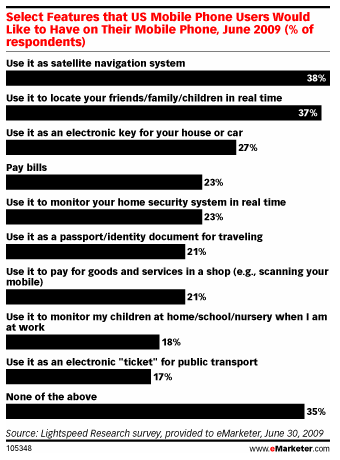Weak signals about mobile technology
529 words | ~3 min
The eMarketer website has published the findings of a study it commissioned from Lightspeed Research on mobile phone use in the US, UK, France and Germany.
For the UK, it's no surprise that texting and voice calls are the most common types of use (82% and 75% at least once a week, respectively), though as eMarketing points out the figure of 22% that browse the internet weekly is a surprise. This seems to me to reflect a change in thinking about what mobile devices are for that has been going on for a few years now, and is most clearly seen in convergent devices like the iPhone and Blackberry.
What's really striking, and not given much comment by eMarketing, is the result for features that US mobile users would like to have on their phones, reproduced here.

Taken on their own, these responses are fairly interesting and provide fairly strong signals about what might come next in mobile: expect to see more devices with satellite navigation and similar GPS tools hitting the market soon, for example. But taken together, I think they reveal something more subtle about how mobile use might change over the next few years.
Several of these responses reimagine mobile devices as tools that transform the relationship between people and the spaces they inhabit. Satellite navigation is the strongest manifestation of this: it tells you where you are and helps you get where you need to be. In doing so it maps data on the real world you inhabit, turning information about distances and directions into instructions that centre on you: turn left, turn right, in 20 yards, stop. But sat nav is just the most obvious version of an idea of mobile devices as things that connect people to the world, and not just in the old-fashioned sense of being able to speak to one another. A mobile device that can locate people and monitor systems remotely is as much a translation device as a communication device, helping people to understand and transcend the physical spaces within which they exist, and to overlay otherwise-invisible layers of data onto the here and now.
It's hard to describe these emerging phenomena without sounding either too technical (talking about embedded sensor architectures) or too mystical (riffing about the demon-haunted world of the internet of things). But it's because these things are at the edge of mainstream understanding that they're worth thinking about. This survey, along with the appearance of the first few augmented reality applications, seems to hint that a new way of thinking about mobile is starting to creep into public consciousness.
# Alex Steer (21/07/2009)